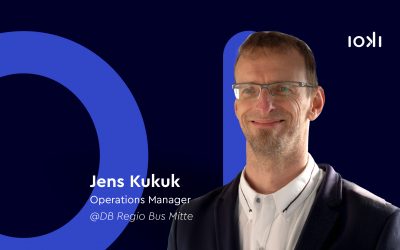ioki insights
Why did Limburg decide on digital on-demand transport?
Michael Stanke
How can we offer our residents a diverse, future-oriented and sustainable mobility? This question has been on our minds in Limburg for a long time. We therefore launched a master plan for mobility in 2018 – public transport is one of the key measures of this master plan. Within the public transport system, our LahnStar is a central component as a flexible shuttle on demand. We wanted to find a solution for the first and last mile, especially in the rural areas of our city. Thus came the idea of an “on-demand system” integrated into the public transport system as a new, modern and digital form of mobility, complementary to the existing public transport service. The outer districts have been wishing for a better connection to public transport for years, and now we can finally fulfil this wish.
The RMV’s OnDeMo project and the funding from the state and federal governments support us in this project. The electric, flexible shuttles ensure fewer journeys by car, which reduces traffic and improves the air quality. The quality of life in Limburg will be improved and at the same time we were able to make the existing and successful AST system more flexible and digital.
ioki insigts
How is on-demand transport used in the city and how are the LahnStar and other means of transport in Limburg and the surrounding area networked with each other?
Hicham Azzou
We have good connections to regional and long-distance transport in Limburg an der Lahn. Regional trains (RB) and regional express trains (RE) connect our city with the most important surrounding communities and cities, such as Frankfurt am Main, Koblenz, Wetzlar or Gießen. In addition, we are fortunate to be connected to long-distance traffic via an exclusive ICE railway station.
Within the city, there are six city bus lines, most of which serve the areas of the inner city. One of the lines provides a special connection to the ICE railway station outside the city. All bus connections in the city’s public transport system run via the three central bus stations (ZOB). As a result, the outer parts of the city are not directly connected to each other. In addition, the timetable synchronisation connected to the ICE station is rather impractical for our passengers.
The on-demand system is used as a feeder service to rail transport and as a connection between the more rural parts of the city that were previously not sufficiently connected to the public transport network. Currently, there are only very few direct connections between the districts. In almost all cases, the route between the city districts by public transport leads via the inner city, with a necessary change at one of the ZOBs. The on-demand service is a supplement to the existing public transport system in which, for example, additional stops have been set up in the residential areas that are served by the LahnStar and thus contribute to a very high level of accessibility of the neighbourhoods. This has significantly improved the service, especially for people who do not live close to existing routes or have destinations there.
ioki insights
What is special about the LahnStar?
Michael Stanke
We have a special setting in Limburg, where we can work with strong regional partners. The electricity and the charging infrastructure come from our regional energy supplier. In the tender for the operation of the vehicles, a local taxi company came out on top, which had previously operated the AST. This is a stroke of luck for us because we can integrate the local taxi industry more strongly into the public transport system. All sides benefit from this. What is new is ioki’s digital technology behind the system enabling intelligent routing and pooling of passenger requests. And the use of electrically powered vehicles is also new.
ioki insights
How is the service being received? Where are the challenges in digitalisation and how are you dealing with them in Limburg?
Hicham Azzou
Our expectations for the on-demand service were exceeded after only a short time. In the first twelve months, over 31,000 passengers used the service and we are thinking about expanding it. Basically, we only receive positive feedback from passengers. The feedback from LahnStar passengers is very important to us, as it allows us to respond to suggestions for improvement and to constantly optimise the service. The challenge now is to further increase the pooling and reduce the rejection rate.
ioki insights
What does the future hold for local mobility in Limburg and the region? What digital offers are still planned?
Michael Stanke
In Limburg, we have set ourselves important goals with the Mobility Master Plan and the Green City Plan to improve air quality in the city by 2030 through new and more attractive local mobility. From our perspective, local mobility and digitalisation should always go hand in hand. In a next step, dynamic passenger information displays with real-time data will be installed throughout the city. In the process, an interface to on-demand mobility ought to be established. The interface to the RMVgo app between the other means of transport, e.g. taxi, sharing offers and on-demand mobility, is also being envisaged.
New mobility offers and digitalisation are the prerequisites for multimodality in the environmental network. The LahnStar shows how it can be done. We are particularly pleased that neighbouring municipalities have also shown interest in on-demand transport. If other municipalities join in, this will increase the share of emission-free transport. Everyone will benefit from this.



